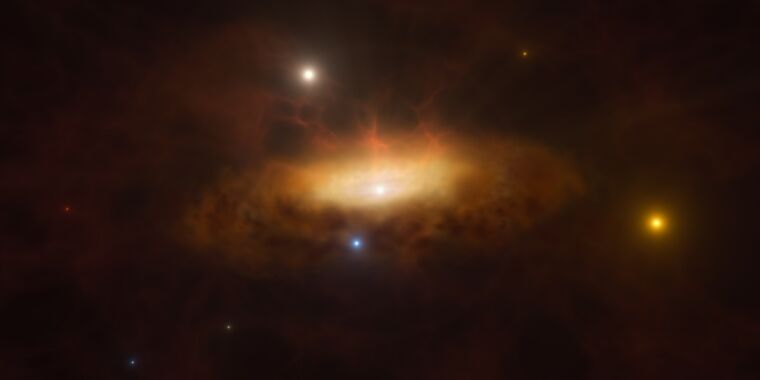In December 2019, astronomers were surprised to observe a long-quiet galaxy, 300 million light-years away, suddenly come alive, emitting ultraviolet, optical, and infrared light into space. Far from quieting down again, by February of this year, the galaxy had begun emitting X-ray light; it is becoming more active. Astronomers think it is most likely an active galactic nucleus (AGN), which gets its energy from supermassive black holes at the galaxy’s center and/or from the black hole’s spin. That’s the conclusion of a new paper accepted for publication in the journal Astronomy and Astrophysics, although the authors acknowledge the possibility that it might also be some kind of rare tidal disruption event (TDE).
The brightening of SDSS1335_0728 in the constellation Virgo, after decades of quietude, was first detected by the Zwicky Transient Facility telescope. Its supermassive black hole is estimated to be about 1 million solar masses. To get a better understanding of what might be going on, the authors combed through archival data and combined that with data from new observations from various instruments, including the X-shooter, part of the Very Large Telescope (VLT) in Chile’s Atacama Desert.



This is the best summary I could come up with:
In December 2019, astronomers were surprised to observe a long-quiet galaxy, 300 million light-years away, suddenly come alive, emitting ultraviolet, optical, and infrared light into space.
That’s the conclusion of a new paper accepted for publication in the journal Astronomy and Astrophysics, although the authors acknowledge the possibility that it might also be some kind of rare tidal disruption event (TDE).
There are many reasons why a normally quiet galaxy might suddenly brighten, including supernovae or a TDE, in which part of the shredded star’s original mass is ejected violently outward.
Astronomers are already preparing for follow-up observations with the VLT’s Multi Unit Spectroscopic Explorer (MUSE) and Extremely Large Telescope, among others, and perhaps even the Vera Rubin Observatory slated to come online next summer.
“Regardless of the nature of the variations, [this galaxy] provides valuable information on how black holes grow and evolve,” said co-author Paula Sánchez Sáez, an astronomer at the European Southern Observatory in Germany.
It may have been active in the past, and it’s possible that it will reawaken again in a few million (or even billion) years when the Milky Way merges with the Andromeda Galaxy and their respective supermassive black holes combine.
The original article contains 561 words, the summary contains 198 words. Saved 65%. I’m a bot and I’m open source!